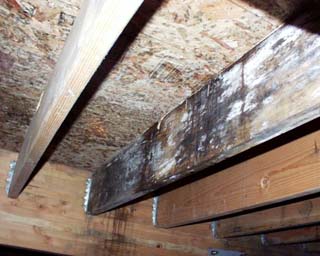|
Subscribe / Renew |
|
|
Contact Us |
|
| ► Subscribe to our Free Weekly Newsletter | |
| home | Welcome, sign in or click here to subscribe. | login |
Construction
| |
 |
October 9, 2003
Precautions during construction will save headaches later
Prezant Associates

Photo courtesy of Prezant Associates
White mold patches are shown on a joist inside the crawlspace of a building under construction. Contractors shouldn’t attempt to cover up such patches with lumber or Sheetrock, since wet materials will transfer the damage to the covering materials. |
Mold and dry rot concerns have been getting a lot of attention lately, most likely because of several legal cases in which millions of dollars have been awarded because of mold infestation in new construction. But is the mold problem really a new one?
Mold has been a problem for builders since pre-biblical times. Over the millennia, however, the more-successful builders employed a few simple techniques that dramatically reduced the risk of mold in their buildings.
Is it possible that in attempting to build more “efficiently,” and by adhering to unrealistic construction schedules, mold is getting the better of us?
Stay dry
Molds are microscopic organisms that are present virtually everywhere in our environment. Molds break down dead organic materials, such as wood and leaves, and recycle nutrients back into the environment. All that is necessary for mold growth to start on these materials is moisture.
| How to keep the mold out |
|
Generally, within 48 hours after getting wet, invisible mold growth has started on wet woods and paper-backed products such as Sheetrock. After about four days, mold growth on surfaces is visible in the form of discoloration, frequently green, gray, brown or black, but also white and other colors.
Because molds digest organic material, they gradually destroy whatever they grow on. Molds also release countless tiny, lightweight spores, which travel through the air. Mold spores primarily cause health problems when people inhale very large numbers of them.
In finished construction, roof and window leaks, plumbing defects, drainage and grading problems, and other sources of water infiltration can trigger the chain of events that ultimately leads to active mold growth.
But in a building that is under construction, what steps can be taken to prevent mold growth?
Preventing mold
Our simple advice is this: Do not build with wet materials. While the Pacific Northwest climate may not lend itself to following this advice easily, there are still several steps a prudent contractor can take to prevent or minimize mold growth.
Because we have seen every one of these precautions violated at one time or another, we feel the contractor community might benefit from the lessons that others have painfully learned:
| Mold conference |
|
Leading mold experts will examine the potential liability of mold, and ways to minimize risk and liability in a one-day conference sponsored by The Seminar Group.
Topic titles include “Anatomy of Building and the Development of Mold,” “Biology of Mold,” “Defending Contractors and Design Professionals” and “Alternative Dispute Resolution.” Scott D. Bissell, an attorney at Stafford Frey Cooper, is the program chair. Other panelists include David A. Deress, Wiss Janney Elstner Associates; Dianne Knutson and Bradley D. Prezant, Prezant Associates; David Merchant, Baker Martin & Merchant; James P. Wagner, Stafford Frey Cooper; R. David Hadaway, Corke Amento; Colin Murphy, Exterior Research & Design; and Gregory L. Bertram, JAMS. The seminar is set for Tuesday, Nov. 4, at The Red Lion Hotel, 1415 Fifth Ave., Seattle. The program begins at 9 a.m. and ends after a question-and-answer session at 5 p.m. Attorneys, contractors, project managers, property owners and managers, and design, engineering and real estate professionals are encouraged to attend. Registration is $395, with discounts available for groups, government, new associates and students. Sign up online at www.theseminargroup.net, or by calling (206) 463-4400. |
If the stockpiles are out in the open, and it looks like it might rain, cover the materials with a good tarp, anchored down so that the wind does not blow it off. When the materials are needed, remove them from beneath the cover without allowing the remainder to get wet or damp.
We have seen buildings under construction with severe mold problems (and even mushrooms growing in the crawlspace). We tell the contractors point-blank that we can do nothing to help until the roof is installed, thereby cutting off the water source from the crawlspace.
A moisture meter is a handy device to make sure the previously wet materials are sufficiently dry to allow construction to proceed.
Mold spreads very rapidly in a moist environment, and the wet materials will serve as a moisture source that will rapidly transfer damage to the previously clean, dry materials.
In addition, the materials might already be structurally or functionally damaged, and paint will not cover that up for long. Most mold-infested porous materials must be removed and discarded.
Plastic, metal, or glass-like materials can generally have the mold cleaned off successfully, because the mold is only growing on surface dust or dirt and does not penetrate into the underlying nonporous substrate.
Find a consultant experienced in assessing mold growth and an engineer experienced in determining the structural stability of the installed materials.
While very few structures need to be torn down because of mold, the remedial and legal costs of ignoring the situation might very well exceed the cost of the new construction.
David Chawes is a certified industrial hygienist and senior consultant at Prezant Associates. He specializes in assessing mold during construction and remodel activities, and can be reached at dchawes@prezant.com.
Other Stories:
- Construction drying keeps moisture at bay
- Time to get serious about moisture
- Consider your options for exterior cladding


